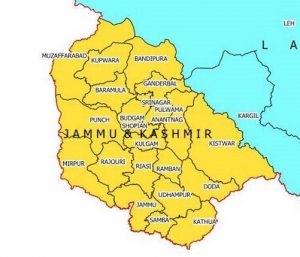
The Union Territory of Jammu and Kashmir came into existence on 31-10-2019 in terms of Jammu and Kashmir Reorganisation Act 2019. The Union Territory of Jammu & Kashmir has been carved out of the Erstwhile state of Jammu and Kashmir that came into being as a single political and geographical entity following the Treaty of Amritsar between the British Government and Mahahraja Gulab Singh signed on March 16, 1846. The Treaty handed over the control of the Kashmir to the Dogra rulers of Jammu who were already controlling the Ladakh region. Thus, the new region comprising three distinct regions of Jammu, Kashmir and Ladakh was formed with Maharaja Gulab Singh as its founder ruler.
The UT is bounded by Ladakh in the East and North and Pakistan in the West. The Southern boundry is contiguous with Himachal Pradesh and Gurdaspur District of Punjab. Its thre principal rivers are, the Jhelum, the Chenab and the Ravi.The J&K with its summer and winter capitals at Srinagar and Jammu, respectively, consists of 20 districts, 10 in Kashmir Valley and 10 in Jammu Division. It has three geographical zones of (i) Sub-mountain and semi-mountain plain known as kandi or dry belt, (ii) the Shivalik ranges, (iii) the high mountain zone constituting the Kashmir valley, Pir Panchal range and its off-shoots including Doda, Poonch and Rajouri districts and part of Kathua and Udhampur districts.The climate varies from tropical in the Jammu plains to semi-arctic cold in Kashmir and Jammu mountainous tracts having temperate climate conditions. The annual rainfall also varies from region to region with 650.5 mm in Srinagar and 1115.9 mm in Jammu. The J&K is geologically constituted of rocks varying from the oldest period of the earth’s history to the youngest present day river and lake deposits.


